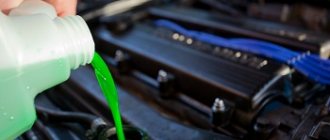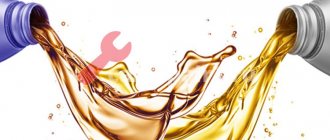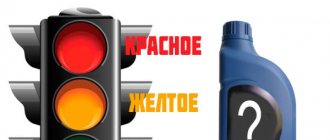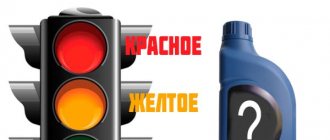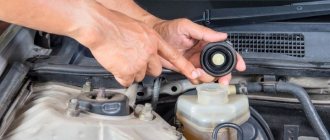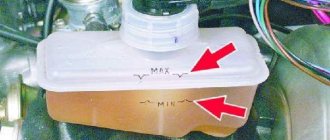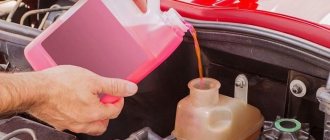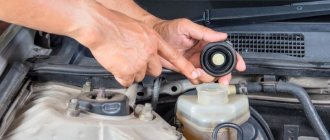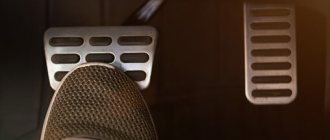01/24/2022 5 276 Coolant
Author: Victor
The circulation of liquid through the cooling system (CO) prevents overheating of the power unit in the car. Therefore, you need to monitor the amount of substance in the tank. When adding it, it must be taken into account that if antifreeze is mixed without taking into account their composition and class, this can lead to problems in the operation of the cooling system. Accordingly, to overheating of the internal combustion engine. We will tell you more about how to properly mix refrigerants below.
[Hide]
What types of antifreeze are there?
To understand the consequences of mixing antifreeze of different colors and how to mix it correctly, let’s look at the main points.
Coolants are divided into two groups:
- salt-based, usually green and blue in color;
- with an acid base, as a rule, have a red tint.
Refrigerant colors may vary as determined by the manufacturer. But manufacturers usually assign just such shades to their products so that buyers do not have difficulties purchasing them. Color does not affect the composition and characteristics, since it is only a dye.
What types of liquids can be found on sale:
- TL. Traditional antifreeze class, painted blue. In composition, this type of substance is more similar to Antifreeze than others.
- G11. Products belonging to this standard are colored green and blue, as well as blue-green. Silicate elements are added to the composition of such mineral antifreezes. Some manufacturers assign orange and yellow colors to liquids belonging to this type. Once in the cooling system, the substance forms a protective film on all its internal components. The disadvantages of such products include their low service life, averaging no more than two years. During operation, the protective layer that appears inside the system begins to crumble and spread throughout it as the liquid circulates. Its residues become an abrasive and disrupt the operation of the CO, leading to problems with heat transfer.
- G12, G12+ and G12++. Such refrigerants have a red color or another shade of it - lilac, pink, violet, etc. Organic liquids of this standard are classified as carboxylate products. The main advantage is local action. If there is rust in the cooling system, G12 antifreeze prevents corrosion from spreading to other elements. This is achieved by adding special additives to the composition. The service life on average is about five years, but if the consumer dilutes the concentrate and adds distilled water to it, then the service life of the refrigerant is reduced to three years. The main disadvantage is that the product does not prevent the formation of corrosion, but only prevents an existing source from spreading. And antifreezes belonging to the G12+ and G12++ standards allow you to remove rust. The refrigerant will not become an abrasive even at the end of its service life, since it does not create a protective film in the system.
- G13. May have a pink, lilac or yellow tint. This product is a hybrid product and, in fact, it is a more advanced version of G12++. The main difference is that the refrigerant is not based on ethylene glycol, but on the safer propylene glycol. This has led to an increase in the cost of the liquid, which is why it is not so popular among consumers today. Manufacturers do not have a uniform standard for antifreeze colors; each company can assign any shade to its product.
What are the same and different in the compositions?
The composition of liquids, especially those belonging to classes G11 and G12, is very similar. They are approximately 80% the same. As a rule, manufacturers use distillate and ethylene glycol as the basis for products of different brands. The remaining 20% consists of additives that perform important functions.
You can learn more about the classification of antifreeze from the video filmed by the Unol Tv channel.
Regarding additives, each manufacturer uses different sets, making their product unique and having the characteristics it needs. Additives are used to remove the destructive effect, which is achieved by mixing distillate and ethylene glycol. The combination of water and this element is chemically active and can lead to the destruction of metal components of the cooling system. Especially the walls of the radiator device and pipes. The use of additives reduces the likelihood of damage.
There are several options for additives:
- Protective. They are designed to cover the cooling system lines. Additives create a special film on internal surfaces that prevents the destruction of metal components. Such additives are usually used in products of the G11 standard, as well as domestic antifreeze.
- Anti-corrosion. They do not create an additional film, but actively remove rust when it appears. Thanks to these additives, the outbreak is blocked, since the chemical elements included in the composition seal it.
- Hybrid. They combine the advantages of the two types of additives described above. Manufacturers of liquids usually mix them in the required proportions.
- Additional additives. There can be many of these. For example, anti-foam, designed to prevent the formation of foam in the cooling system.
Antifreeze markings G11, G12, G13 and what is their difference
In America there is no special classification, so it is unlikely that it will be possible to determine the color of the anti-freeze by the labeling. In Russia and the CIS countries, the European classification of antifreeze established by the Volkswagen automaker has been adopted. The color is indicated by the marking:
- G13 - replaced the outdated G12+. Indicates orange, yellow and purple compounds made from propylene glycol. The first batches were produced in red. They are considered the least toxic and quickly decompose in the natural environment. The quality is superior to all other varieties, so their price is the highest.
- G12 – red, contain corrosion inhibitors based on carboxylic acids. Unlike G11, they have a longer service life - up to 5 years.
- G12+ - orange, now the marking has been replaced by G13.
- G11 - green, yellowish, turquoise and blue. They are budget-friendly; their main advantage is their high lubricating properties. There are two subclasses - G11++ and G1+, differing in the content of carboxylic acids.
Mixing different colors and brands
It is possible to mix red and blue refrigerant, green and yellow, as well as other colors of the same or different manufacturers in the heating system if both liquids have the same characteristics. Each antifreeze is colorless before adding dye to the composition. The main difference in the products is not the shade, but the quality itself. One coolant may be designed to protect the cooling system from rust, another for lubricating properties, and a third has a specific temperature range.
User Nikolay Dergunov published a video that will help you understand the issue of mixing different antifreezes.
All refrigerants can have different freezing and boiling temperature thresholds, and can also be aggressive to metal and rubber elements to varying degrees.
If two liquids that do not match each other in composition are mixed, this is fraught with the following consequences:
- Deposits will begin to appear in the cooling system, which will lead to the formation of a mixture. Because of this, antifreeze will lose its characteristics, which will reduce its service life. As a result of the conflict between different additives, the chemical components refuse to work with each other. The liquid becomes thick and forms a mixture that is unable to circulate normally through the cooling system. Because of this, its lines become clogged and the CO becomes inoperable as a whole, and, as a result, the engine overheats. This problem can be solved by flushing. If cleaning is not done in a timely manner, it will be necessary to replace the pipes.
- It will be worse if the chemical molecules present in the liquid begin to work against each other. As a result, you will have to not only change the refrigerant, but also flush the cooling system; sometimes its elements may fail.
- Foaming will occur. This problem is faced by many consumers who have mixed antifreezes of different compositions and additives. Foam appears in the expansion tank, as well as in the cooling system pipes. There is no point in adding new liquid that has anti-foam additives to the tank. The CO must be completely rinsed several times, and then fresh product must be poured into it.
If the hoses and lines of the cooling system are critically clogged, the following may occur:
- accelerated wear of bearing parts and their destruction;
- failure of the water pump caused by excessive heating of the mechanism;
- overheating of the cylinder head gasket and the engine as a whole, which contributes to deformation and wear of the cylinder head gasket, as well as jamming of the pistons (failure to solve the problem in a timely manner will lead to their failure).
If you constantly use the same antifreeze composition, then your engine will not face problems.
Damaged CO radiator
Scale on the radiator device
Deposits in CO
CO hoses before and after cleaning
Characteristic
First of all, we note that any coolant, whether foreign or Russian, is colorless. This factor does not affect the quality in any way. “But why then are they multi-colored?” - you ask. Which antifreeze to choose - red, green, blue? What is the difference? Manufacturers classify their products in this way. Any liquid is distinguished by the presence of components that prevent it from freezing at low temperatures. This figure can range from minus 15 to minus 40 degrees Celsius. Below we will look at the differences.
Dilute correctly
The cooling system should not be allowed to operate on several different antifreezes at once. If two or more species are mixed, the composition must be taken into account. It is important that the liquids have a similar base. Mixing any brands is allowed, although this is not recommended and only applies to high quality products. Refrigerants belonging to the G11 standard can be diluted with any antifreeze except G12. As for G12 fluids, they can only be mixed with similar refrigerants or with products that fall under the G12+ standard. You cannot mix with substances of another class.
G13 refrigerants can be diluted with G12+ and G12++ fluids. Mixing antifreeze with domestically produced antifreeze, which is considered a more aggressive agent for many imported cars, is not allowed. Because these products have fundamentally different bases. We have figured out why it is impossible to mix refrigerants of different compositions; special mention should be made about dilution with water.
If you have detected a lack of liquid in the OS, then you can replenish the volume with distillate, but this is only allowed in the warm season. In cold weather, adding water can cause it to freeze in the cooling system, which will negatively affect the functionality of the elements. Do not use tap liquid for mixing, as the composition contains substances that will lead to the formation of rust and scale. As a result, this will cause clogging of the highways. In cold weather, it is not worth adding water to the concentrate, since it is usually at least 65% in any refrigerant.
Violet
Few of us have seen them in person, but such means also exist. They appeared relatively recently - in 2012. Belong to the 13th group. Purple represents lobrid antifreezes that do not contain ethylene glycol. It is believed to be highly poisonous. But how does it ensure heat removal if the main composition is without ethylene glycol? Instead, manufacturers use more environmentally friendly propylene glycol. It is less toxic and environmentally friendly. As for other components, purple antifreeze contains silicates and carboxylic acid, already known to us as an anti-corrosion agent in previous groups.
What to do if you have filled in antifreeze of a different classification?
The VChSLV channel in its video showed the process of flushing the cooling system, as well as replacing antifreeze.
Mixing different types of refrigerants in a car's cooling system and not flushing it out promptly will cause deposits to form. As soon as possible, cleaning is done, which will require at least 10 liters of distilled water.
Execution process:
- Open the hood and let the car engine cool.
- Place a container under the antifreeze drain hole or under the radiator into which the waste will flow.
- Use a wrench or your hands to remove the plug. The spent substance will begin to drain.
- When the liquid comes out, screw the lid on.
- Fill the cooling system with distillate. Its volume should correspond to the amount of liquid drained. You can add citric acid to the water (at the rate of 1 kg per 10 liters of distillate for severe contamination or 800 grams per 10 liters for non-critical deposits).
- Start the engine and let it run for about 15-25 minutes.
- Unscrew the drain plug and wait until the water comes out of the system.
- Remove the expansion tank. Sediment collects at its bottom. Clean the tank thoroughly. If the contamination is strong and is not washed out, the container is replaced with a new one and then replaced.
- If the drained liquid is too dirty and contains traces of scale or deposits, repeat the flushing procedure again. Carry out cleaning until the water drained from the system becomes clear. Then you can fill in new antifreeze. We recommend assessing the condition of the cooling system pipes. If they are severely clogged and flushing does not solve the problem, the hoses should be replaced. Also look at all gaskets and seals. If they are worn out and in critical condition, these components must be replaced.
Video “How to properly flush the cooling system?”
User Lesha Master published a video in which he showed the cleaning process and explained all the nuances of performing this task.
Do you have any questions? Specialists and readers of the AUTODVIG website will help you ask a question
Was this article helpful?
Thank you for your opinion!
The article was useful. Please share the information with your friends.
Yes (62.50%)
No (37.50%)
X
Please write what is wrong and leave recommendations on the article
Cancel reply
Rate this article: ( 8 votes, average: 4.63 out of 5)
Discuss the article:
